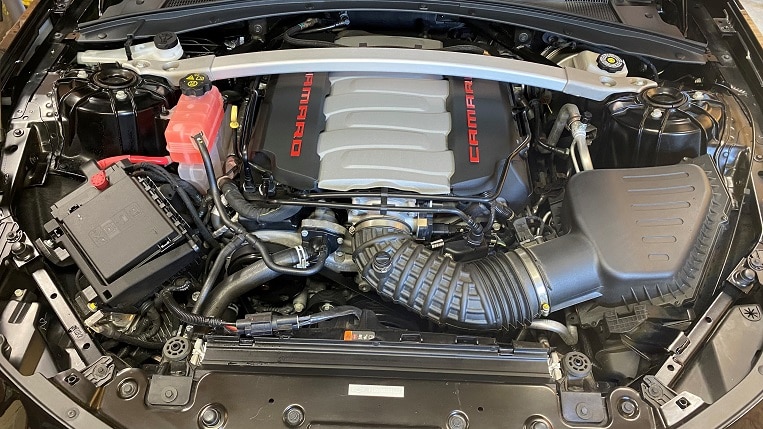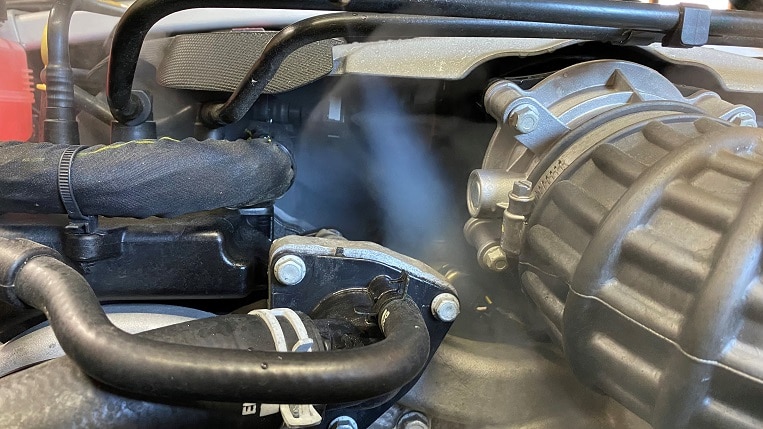Water and electricity are best kept separate. Although modern engines and electrical connectors are more water-resistant than before, dousing them with water is not good. While some water finds its way into the engine bay when driving in the rain or snow, it doesn’t compare to the amount of water coming from a hose.
So, how can you clean under your car’s hood? Vapor steam cleaners are one of the most effective ways to clean the engine bay. It’s also less harmful to components because of the method’s low moisture content of roughly 5%. Still, be careful when cleaning around electrical connections, spark plugs, and the alternator, which can be more susceptible to water damage. Fixing water damage can cost a few hundred dollars for a new alternator or more than a thousand dollars for cylinder head replacement from seized spark plugs.
Steam cleaners have incredible cleaning power, with temperatures upward of 300 degrees Fahrenheit and pressure levels of 75 pounds per square inch (psi). Also, using an all-purpose cleaner helps clean baked-on engine gunk. Presoaking the engine in the cleanser and agitating with various brushes will loosen the contamination and allow the steam to clean surfaces effortlessly. After the engine compartment looks spotless, it’s best to add a plastic, vinyl, and rubber protectant. Applying protectant under the hood makes engine covers and hoses look better and can help extend their lifespans.
Engine Steam Cleaning Explained
- Benefits of a Clean Engine
- Steam Cleaning vs. Pressure Washing
- Should I Steam Clean My Engine?
- Engine Steam Cleaning Instructions and Tips
Benefits of a Clean Engine
The engine bay is often not included during car detailing and might only receive attention every few years or when it’s time to sell the vehicle. When was the last time you had a peek under the hood of your car, truck, or SUV? Unless you change your engine oil and perform other essential maintenance, the answer is possibly never. Maintaining a clean engine bay has multiple benefits in addition to looking good.
Easier Engine Maintenance – A clean engine is always welcome by the mechanics working on your car. It is easier to spot leaks and pinpoint the source when the surface is free of dirt and debris. Discovering leaks early can help prevent more expensive damage farther down the road. Also, dirt holds onto moisture and can cause accelerated corrosion on metal parts because they are constantly damp.
Extended Engine Life – Steam cleaning the engine bay can help extend engine life and reduce the risk of fires. Keeping contamination buildup to a minimum will help reduce rust and prevent plastic, vinyl, and rubber from drying out. Conditions in the engine bay can be pretty extreme, with plenty of heat that can spell disaster for an engine covered in grease, oil, or fuel.
Increased Resale Value – Last but not least is increasing the vehicle resale value. Have you ever sold a car and asked yourself, “Should I have cleaned my car before selling it?” The answer is going to be a strong “YES!” Performing a presale car detail that includes the interior, exterior, and engine compartment will increase the value of a vehicle and help it sell faster. A clean engine gives prospective buyers peace of mind because it can indicate proper car maintenance.
Steam Cleaning vs. Pressure Washing
There is more than one way to clean an engine, and each method has its benefits and drawbacks. Two popular engine cleaning methods are vapor steam cleaning and pressure washing. Steam cleaning is safer than pressure washing but is usually more time-consuming. Also, a commercial-grade steam cleaner isn’t necessarily cheap or something many people can access. A consumer-grade steam cleaner will get the job done to a comparable level, but it will take a lot more time.
A high-end vapor steam cleaner is the way to go when cleaning dirty and delicate areas of the car. The vapor steamer produces low moisture steam, usually around 5% water, making them a safe option for cleaning delicate engine components. More expensive steam cleaners may have a continuous fill feature. With this functionality, if the boiler runs out of water midway through an engine compartment detail, you don’t need to wait to add more water. Consumer steam cleaners typically must cool down before adding more water to the boiler, or severe burns can occur.
Pressure washing is another way to clean the engine bay, but it has unique risks. While the steam cleaner is more likely to cause injury to the person using it, a pressure washer is more likely to damage the engine. A steam cleaner might use a gallon of water per hour at around 100 psi. For comparison, a pressure washer may use a gallon per minute and over 1,000 psi. Be careful when using a pressure washer because the extra water and higher force can cause issues for specific engine components.
Should I Steam Clean My Engine?
Is your car more than a few months old, or has it been a while since the last engine bay cleaning? If so, steam cleaning the engine should be on the to-do list of vehicle maintenance. Steam cleaners are relatively safe for DIY detailers, and entry-level models cost around $200. If you’re more comfortable having a professional detailer clean your engine, the cost is approximately $75.
Engines will benefit from more frequent cleaning if the car, truck, or SUV is driven off-road in dusty conditions. In addition to cleaning the engine, replacing the air filter to keep the engine operating at peak performance is a good idea.
Engine Steam Cleaning Instructions and Tips
Steam cleaners use boiling water, sometimes more than 300 degrees, so be cautious when operating one. When the steam starts and stops coming out of the nozzle, there will usually be a spurt of scalding water for a second or two. Always point the nozzle away from what you are trying to clean, and be careful that boiling water doesn’t drip on any exposed skin when starting or stopping the flow of steam.
Applying an all-purpose cleaner and agitating with various brushes will help the steam cleaner make short work of even the most stubborn engine grime. After presoaking the engine bay with an all-purpose cleaner and letting it sit for a few minutes, the surfaces are ready for steam cleaning. Occasionally a second application of the cleaner is required, and the heat from the first round of steam cleaning will help increase the cleaning power.
After the engine bay is spotless, applying a plastic, vinyl, and rubber protectant is the final touch. Many products on the market will provide months of protection between applications. However, a ceramic coating is the best choice if you’re looking for a product with more long-term protection.
Engine Steam Cleaning Step-by-Step Instructions:
- Open the hood and make sure that the engine isn’t hot.
- Remove the plastic engine cover if applicable.
- Apply all-purpose cleaner with care to avoid sensitive areas of the engine.
- Agitate the cleaner with various brushes and let it sit for a few minutes.
- Steam clean the engine bay to begin removing dirt and debris.
- Use a microfiber towel to remove the loosened contamination.
- Dry the engine bay using microfiber towels and forced air if available.
- Apply plastic, vinyl, and rubber protectant or ceramic coating.












